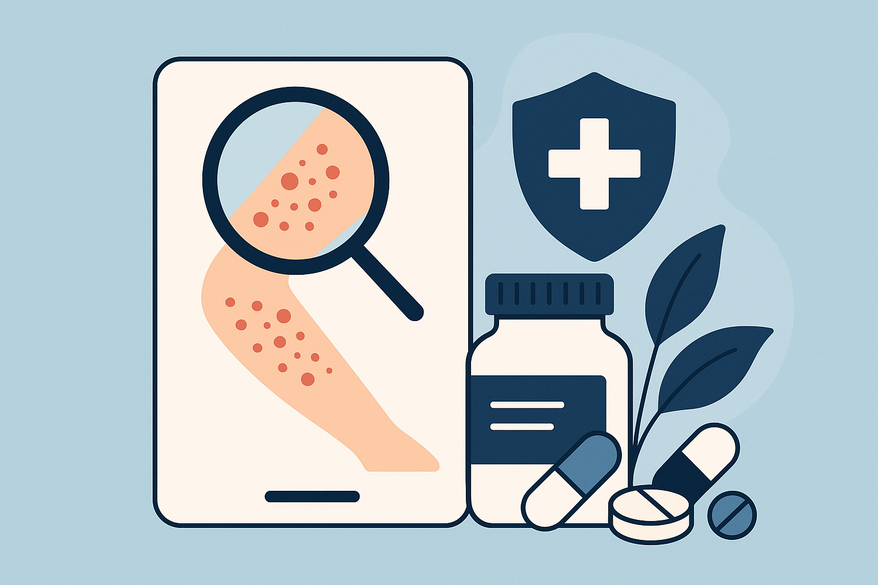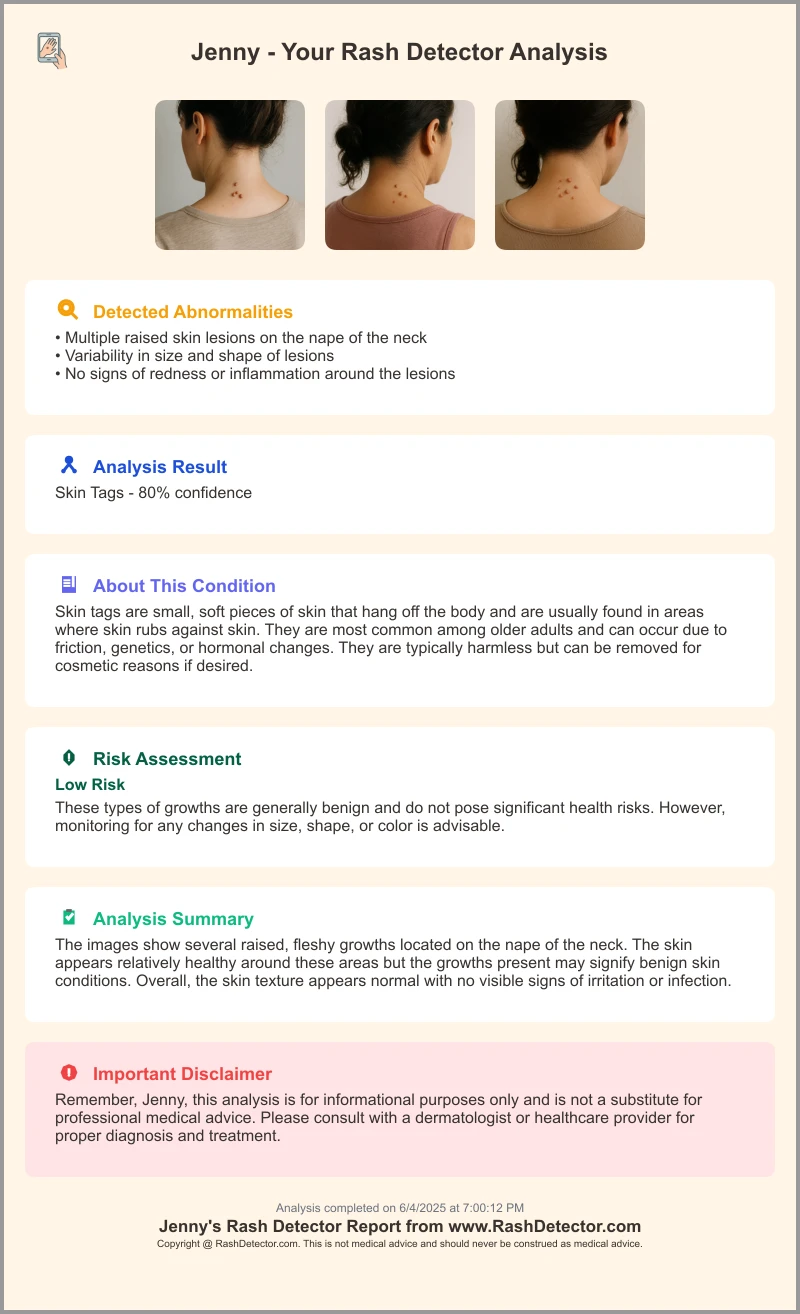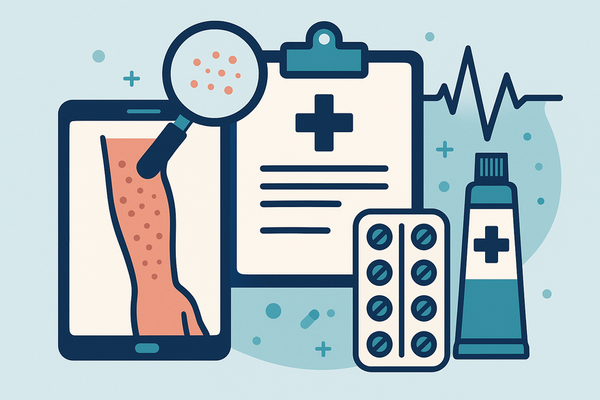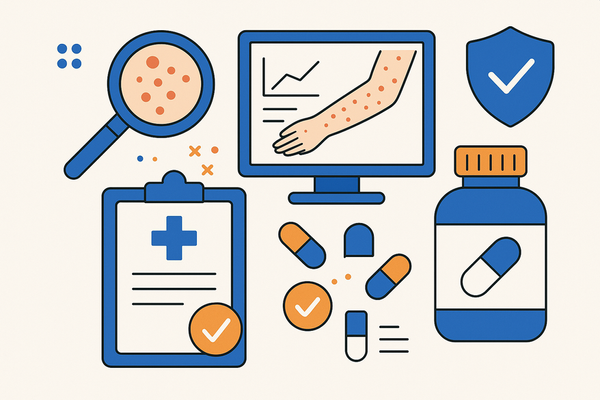Comprehensive Guide to Medication Rash Treatment
Learn how to identify, manage, and prevent medication rashes effectively with our comprehensive treatment guide. Ensure quick relief and prevent complications.

Estimated reading time: 7 minutes
Key Takeaways
- Recognize the common types and symptoms of drug-induced rashes.
- Identify early warning signs to start prompt treatment.
- Apply home, OTC, and prescription interventions in a stepwise approach.
- Spot red flags that require immediate medical attention.
- Implement prevention strategies to avoid future reactions.
Table of Contents
- Section 1: Understanding Medication-Induced Rashes and Medication Rash Treatment
- Section 2: Identifying a Medication Rash to Guide Treatment
- Section 3: Medication Rash Treatment Options
- Section 4: When to Consult a Healthcare Professional for Medication Rash Treatment
- Section 5: Preventative Measures and Long-Term Medication Rash Treatment Management
- Conclusion
Section 1: Understanding Medication-Induced Rashes and Medication Rash Treatment
A medication rash is a drug-triggered immune or non-immune response in the skin. It often appears as redness, itching, or raised bumps. Proper treatment begins with understanding how and why these reactions occur.
How Drugs Trigger Skin Reactions
- Allergic reactions: The immune system mistakes a drug for a threat, releasing histamine and causing inflammation.
- Non-allergic side effects: Drug or metabolite buildup irritates skin cells directly.
- Photosensitivity: Certain medications increase UV sensitivity, leading to sun-induced rashes.
Types of Medication Rashes
- Morbilliform (measles-like): Widespread flat and raised red patches.
- Urticarial (hives): Intense itching, raised welts, sometimes forming rings.
- Fixed drug eruption: A single or few lesions that recur at the same spot when the drug is reintroduced.
- Photosensitivity rash: Red, swollen patches in sun-exposed areas.
Symptoms and Features
- Redness, itching, and swelling
- Blistering or peeling skin
- Possible fever, joint pain, or signs of anaphylaxis in severe cases
For more detail on early signs and when to seek help, see Identifying and Managing Drug-Induced Rash Symptoms.
Section 2: Identifying a Medication Rash to Guide Treatment
Spotting a drug rash early makes treatment simpler. Look for these key signs and patterns.
Onset and Appearance
- Sudden rash within days of starting a new medication
- Widespread redness versus localized bumps
- Rapid spread or slow progression
Signs and Symptoms to Watch
- Persistent itching or stinging
- Mouth sores or ulcers
- Swollen lymph nodes or glands
- Fever accompanying skin changes
Benign vs. Urgent Reactions
Benign signs (self-limiting):
- Mild redness or slight itch in a small area
- No systemic symptoms
Urgent red flags (seek medical care):
- Blistering, skin peeling, or raw areas
- High fever (above 100.4°F)
- Difficulty breathing or swallowing
- Swelling of face, lips, or throat
Risk Factors Increasing Rash Likelihood
- History of eczema, asthma, or prior drug allergies
- Multiple medications (polypharmacy)
- Compromised immune system (HIV, autoimmune disease)
Early identification is a critical first step in medication rash treatment.
Section 3: Medication Rash Treatment Options
Use a tiered approach: remove the trigger, ease symptoms, then step up to prescription therapy if needed. This hierarchy ensures safe and effective relief.
A. Natural & Home Care Measures
- Cold compresses: Numb skin and reduce swelling.
- Oatmeal baths (colloidal oatmeal): Calm inflammation and soothe itch.
- Aloe vera gel: Anti-inflammatory, cooling relief.
- Plant oils (coconut, jojoba): Lock in moisture, restore barrier function.
- Baking soda paste or bath: Neutralize irritants and relieve itch.
- Herbal caution: Witch hazel, chamomile may help but can trigger allergies.
B. Over-the-Counter Remedies
- Calamine lotion: Dries oozing areas and soothes itch.
- Zinc oxide ointment: Creates a protective barrier to shield skin.
- Oral antihistamines (diphenhydramine, loratadine): Block histamine to relieve persistent itching.
C. Prescription Treatments
- Topical corticosteroids: Potent anti-inflammatory creams for moderate to severe rashes.
- Non-sedating oral antihistamines: For systemic allergic reactions without drowsiness.
- Medical consultation: Always check with your healthcare provider before starting prescription therapy.
For a side-by-side comparison of when to escalate care, see our OTC vs Prescription Rash Treatment guide.
For an at-home quick analysis, consider Rash Detector, an AI skin analysis app that delivers instant insights based on uploaded rash photos.

Section 4: When to Consult a Healthcare Professional for Medication Rash Treatment
Some drug rashes demand prompt medical attention. Don’t delay if you see any of these red-flag signs:
Red-Flag Symptoms
- Difficulty breathing or swallowing
- Swelling of the tongue, lips, or throat
- Extensive blistering or skin peeling
- Rash with high fever, joint pain, or widespread malaise
What to Expect in Consultation
- Comprehensive medication history and allergy review
- Physical exam of rash pattern and distribution
- Possible allergy testing or blood work
- Plan to stop or replace the offending drug
Timely professional care ensures safe management and prevents severe complications.
Section 5: Preventative Measures and Long-Term Medication Rash Treatment Management
Prevention is a key pillar of medication rash treatment. Incorporate these strategies to lower your risk.
Disclose and Document
- Always inform providers of past drug rashes or allergies
- Maintain an up-to-date list of all medications, vitamins, and supplements
Follow Directions and Monitor
- Take medications exactly as prescribed—no skipping or doubling doses
- Watch for early symptoms in the first days after starting a new drug
Protect Your Skin
- For photosensitizing drugs: use broad-spectrum SPF 30+, wear sun-protective clothing, and limit midday sun
- Apply fragrance-free moisturizers daily to strengthen the skin barrier
Discuss Preventive Supplements
- Zinc and flaxseed oil may support skin health—talk with your clinician before starting supplements
For additional long-term strategies, check out 10 Expert Tips to Prevent Recurring Rashes and Maintain Healthy Skin.
Conclusion
A solid medication rash treatment plan starts with knowing how to identify drug-related skin reactions, applying home or OTC measures, and escalating to prescriptions when needed. Recognize red flags—like severe blistering or breathing issues—and seek medical help immediately. Consistent prevention strategies, clear communication with providers, and careful skin care help avoid future rashes. Prompt treatment ensures comfort, safety, and peace of mind. Share this guide to help others recognize and manage medication-induced rashes effectively.
FAQ
- What causes medication rashes? Medication rashes arise from allergic immune responses, direct irritation by drug metabolites, or photosensitivity triggered by UV exposure.
- How long do medication rashes usually last? Most mild rashes resolve within a week of stopping the offending drug; severe reactions may take several weeks and require medical treatment.
- When should I seek immediate medical attention? Seek help if you experience blistering, skin peeling, difficulty breathing, swelling of face or throat, or high fever alongside the rash.
- Can I treat a medication rash at home? Yes—cold compresses, oatmeal baths, aloe vera, and OTC antihistamines often relieve mild rashes. Always monitor for worsening symptoms.
- How can I prevent future medication rashes? Document all drug allergies, follow dosing instructions, protect skin from sun, and discuss preventive supplements with your clinician.





